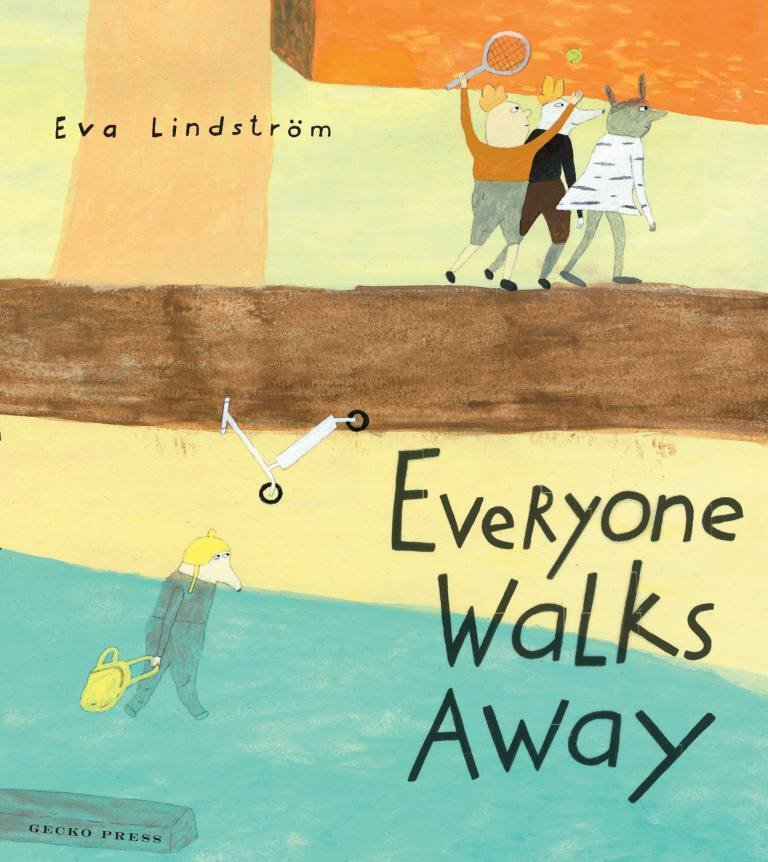Some friendly books — reviewed by Stella
After a request for children’s picture books about making friends and getting on with others, we had a decent stack on our table. Here’s a selection from the pile.
You and Me and Everybody Else is a wonderful book about what makes us different, but more importantly what we have in common. Its bold colours, playful design, and Playmobil-like characters are instantly appealing. On every page, there is action (plenty of activities are taking place), but also quiet spaces where children rest, read, chat, and relax. The text at the bottom of each page has repeating lines creating a sense of familiarity which works well as a read-aloud. Each paragraph starts with ‘everybody’, then moves on to ‘some’. Everybody loves to play. Everybody learns new things. Everybody gets angry, Everybody dreams. / Some like to play with others. Some learn by doing it themselves. Sometimes things don’t work out. Some dream of things that don’t exist yet. Children play, get bored, are happy and sad, are lonely and scared, laugh, eat and sleep. They dream and are surprised. The illustrations show children building with blocks, on swings and slides, waiting and watching, alone, and with friends, giving gifts and frights, falling off bikes, playing chess, making music, and making art. There is a diverse range of activities and cultures on every page and the table spread for lunch has noodles and fruit, pizza and popcorn, couscous, and sushi. [>>Look inside.]
In Eva Lindstrom’s Everyone Walks Away things aren’t so straightforward. Frank is always alone. The others (Tilly, Paul, and Milan) are having fun, and they have each other to play with, and they laugh together, not always kindly. When Frank wanders off to the surprise of the others, Tilly, Paul, and Milan become curious. Where has he gone? They follow at a distance. Frank has gone home to cry, and like Owl (in Owl at Home) he’s making tear-water tea letting his tears fall straight into the pot. Later when the tea has been made with the much-needed sugar (if you look closely, you will see Frank is a jam connoisseur) and cooled by the breeze from the window, Frank makes toast and gets things ready. Will anyone come to drink and eat? Maybe. Or will the others keep larking about outside? Lindstrom’s illustrations are a mix of watercolour, gouache, and pencil giving the pages a delightful and sometimes dreamy aspect juxtaposed with deft detail. Her colour palette for this book of yellows, blue-greens, and oranges is strangely attractive. Humour threads its way through the illustrations; there are suggestively sly side glances, and her children’s personalities are expressed by their quirky, slightly animalish features. Tilly’s braided green hair sticks up like perky animal ears, two of the children have snouts rather than petite noses and Frank’s yellow helmet hat gives him a mole-like aspect. The more times you read this sweet sad story, the more you will notice. And I think there might be a happy ending. [>>Look inside.]
There’s more crying in The New Friend, but don’t worry; this is an optimistic tale. Having a best friend is excellent. Losing a best friend is difficult. The excellent author Charlotte Zolotow manages to talk about betrayal, sadness and anger, and the empowering action of overcoming a difficult situation without resorting to easy saccharine answers. At the beginning is memory. Memories of all the wonderful things you did with your friend. Walking in the woods, listening to the rain, picking flowers, eating apples in a tree, and reading books together. And then, they are no longer there. They are with a new friend, sharing all your wonderful friendly things. You’re sad and mad. You cry until you fall asleep. You dream of a someone else. They take you on new paths with different adventures to places you have never been before. When you wake up, it’s time to go in search of this new friend. Looking for them is an adventure in itself, and your memory of your first friend is tucked inside. This classic Zolotow story (first published in 1968) has fresh joyful illustrations by Benjamin Chaud. Chaud’s style is both quiet (the rain falling over the rooftops, the soft wallpaper that cocoons the child in bed) and effervescent (running across the field, a jaunty sun umbrella for a reading shelter) capturing the different moods of the text. There are small birds flittering through the pages and a rabbit popping up when least expected which add little, surprising details to this dreamy thoughtful, and hopeful landscape. [>>Look inside.]



